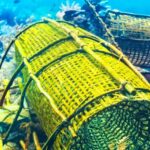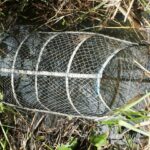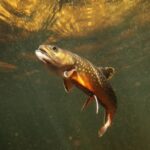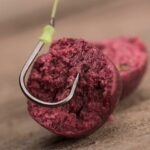Perhaps you’ve been fishing in a freshwater lake or stream and caught a small, yellow fish that looks identical to a blue gill except for its color. You may conclude that your catch is a sunfish, but it may be a pumpkinseed fish. Keep reading to learn the pumpkinseed fish’s identifying markers, habitat, and facts.
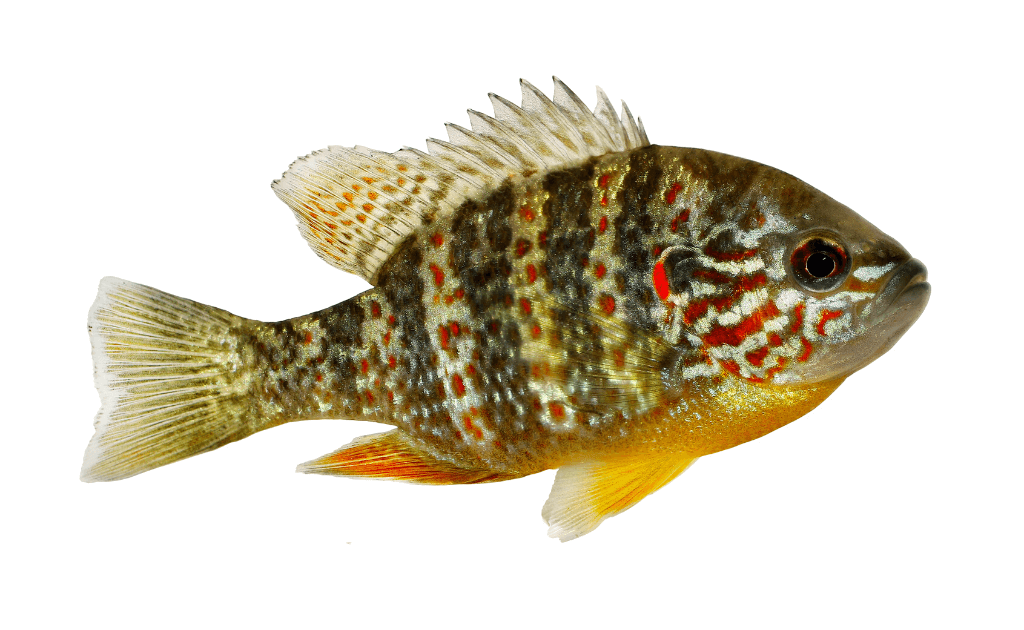
What Is a Pumpkinseed Fish?
A Lepomis gibbosus, more commonly known as a pumpkinseed fish, are a species of small, freshwater fish native to the eastern united states. The pumpkinseed fish derives its name from the shape of its body, which resembles a pumpkin seed. Pumpkinseed fish live in bodies of clear freshwater and prefer shallow depths near the shoreline.
Pumpkinseed fish are abundant and frequently travel in schools, making them ideal game for anglers and sports fishermen. Pumpkinseed fish are popular among novice anglers because of their abundance, geographic range, and modest size.
What Species Is a Pumpkinseed Fish?
Pumpkinseed fish belong to the genus of Lepomis or true sunfishes. Lepomis fish, like the bluegill and pumpkinseed, have laterally compressed bodies with spiny dorsal fins.
Other notable features of the pumpkinseed fish include a small terminal mouth, pointed pectoral fins, and a forked tail. A terminal mouth is one located at the end of a fish’s head that points forward. Pectoral fins are the fins located on the sides of fish.
What Is the Difference Between a Bluegill and a Pumpkinseed Fish?
Pumpkinseed and bluegill fish belong to the same genus and share many characteristics, including a slightly forked tail, a smooth edge up to the gill cover, and a flap that projects from the gill cover.
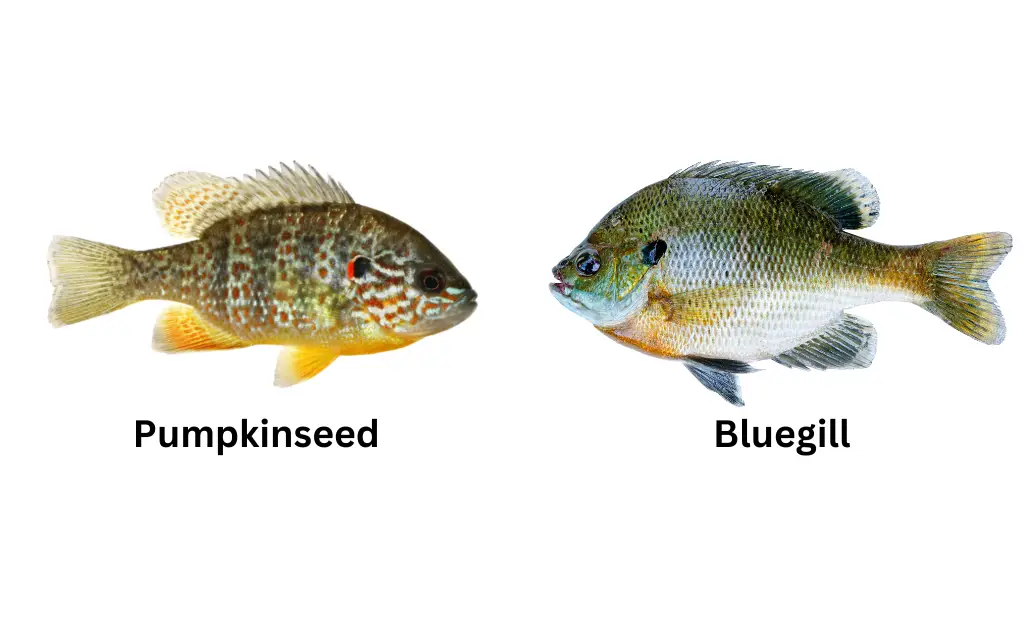
Frequent interbreeding of naturally occurring Lepomis species complicates the differentiation process. Because of the similarity of their features, distinguishing between a bluegill and a pumpkinseed can be difficult. However, there are differences between the two species’ coloration:
- The gill cover of the pumpkinseed fish features a brightly colored orange or red spot unique to the species.
- Pumpkinseed fish also lacks the dark, blotchy coloration on the end of the dorsal fin of the bluegill.
- Male pumpkinseed fish feature bright, iridescent colors used to attract mates.
What Do Pumpkinseed Fish Eat?
Pumpkinseed fish eat small prey, including minnows, worms, insects, and occasionally other small pumpkinseed fish. In addition to prey, pumpkinseed fish can consume small amounts of aquatic vegetation, such as algae. Pumpkinseed fish feed during the day, traveling to different sections of their habitat to source prey. Extremely southern populations of pumpkinseed fish may have large jaw muscles to aid in the digestion of large mollusks and crustaceans.
How to Catch a Pumpkinseed Sunfish
Pumpkinseed fish are easy to catch with small lures and correctly sourced bait.
To catch a sunfish:
- Check the fish demographics at your fishing hole. Have pumpkinseed fish been caught in the body of water you’re fishing in before? Ask your local fishing supply store for information about bodies of water with known pumpkinseed fish populations.
- Locate the local population of pumpkinseed sunfish. Remember that pumpkinseed fish prefer clear freshwater and congregate in shallow waters near the shore.
- Fish during the afternoon. Pumpkinseed fish feed during the day and are especially active during noon.
- Use a small lure that can easily fit inside the mouth of the pumpkinseed fish. Pumpkinseed fish respond well to live bait. Consider using worms or small insects as bait because they mimic the natural diet of the pumpkinseed fish.
- Cast your line into patches of aquatic vegetation in clear waters along the shower. A bob indicator may improve bite visibility in thickly vegetated or murky waters.
- Wait for a bite, then reel it in. Remember that pumpkinseed fish are small to medium-sized fish with a bright orange spot near the gills.
In some cases, you may notice that pumpkinseed fish bite too frequently, preventing you from catching other fish. To prevent this, you can use pumpkinseed fish as live bait for many larger fish species like northern pike and largemouth bass.
Where Can I Catch a Pumpkinseed Sunfish?
Pumpkinseed fish are an abundant game fish native to bodies of freshwater in the eastern United States. If pumpkinseed fish are native to your location, then catching one should be straightforward. Tip: ask neighbors, other fishermen, or your local fishing supply staff where to find pumpkinseed sunfish.
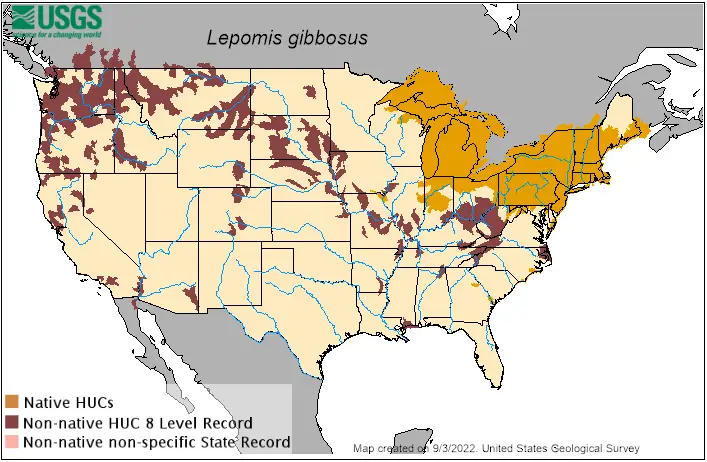
Alternatively, you can scout potential pumpkinseed sunfish habitats by using this free map. Keep an eye out for shallow, ambling creeks or rivers when locating pumpkinseed sunfish habitats on Google Earth.
Lures that Catch Pumpkinseed Fish
You can use a variety of lures to catch pumpkinseed fish. A good starting lure will mimic the fish’s natural diet. Try to find a minnow fry or worm lure to increase your chances of catching a pumpkinseed fish. Alternatively, opt for live bait like crickets.
How Big Do Pumpkinseed Fish Get?
Pumpkinseed fish are small to medium-sized fish that vary in length from four to eight inches. Most pumpkinseed fish weigh less than a pound, although larger specimens exist. Most pumpkinseed fish are roughly four to six inches long and weigh anywhere from a quarter to half a pound.
Are Pumpkinseed Fish Edible?
Yes, pumpkinseed fish are edible. Pumpkinseed fish flesh has a mild, flaky-textured flesh with a slightly sweet flavor. Before eating a pumpkinseed fish, descale, deadhead, and gut it. Pumpkinseed fish are amenable to a variety of cooking methods. Try them roasted over a fire with salt or pan-fried with lemon, pepper, and butter.
Can I Keep Pumpkinseed Fish in an Aquarium?
Pumpkinseed fish can be pets in large aquariums. The bright coloration of male pumpkinseed fish is an attractive compliment to any freshwater fish aquarium. However, be careful when adding pumpkinseed fish to an aquarium because they can be aggressive towards other fish.
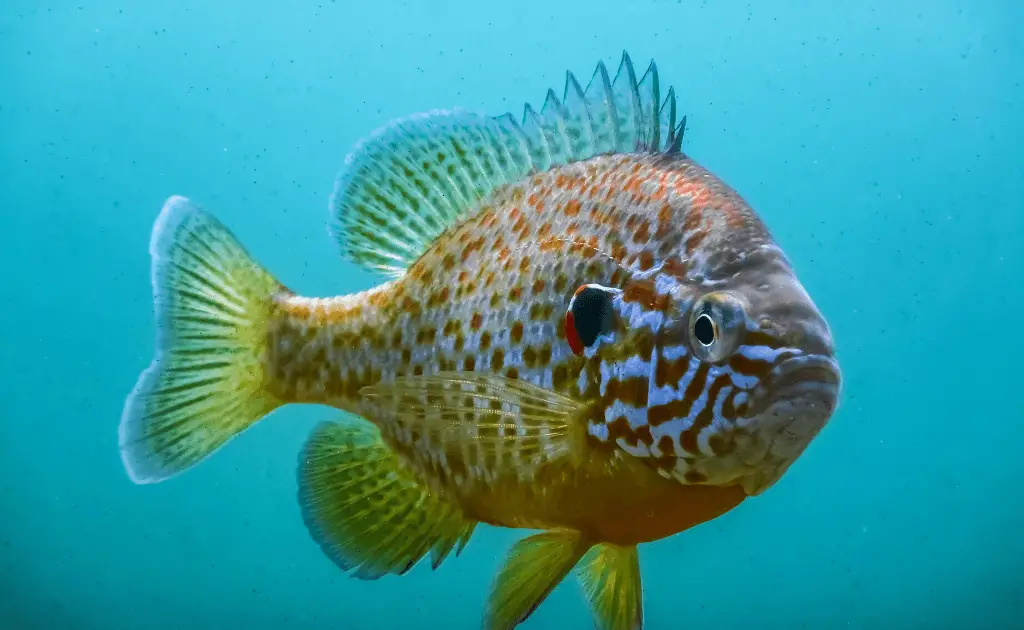
Pumpkinseed Fish Frequently Asked Questions
Below are some common questions sport fishermen and beginner anglers ask about pumpkinseed fish.
Are pumpkinseed fish good to eat?
Yes, pumpkinseed fish are good to eat. Fresh caught pumpkinseed fish are safe for consumption given that the body of water they are from is free from toxic pollutants like antibiotics, pesticides, or oil-based products. If you are unsure about the water quality where you are fishing, do not consume wild pumpkinseed fish.
What does pumpkinseed fish taste like?
Pumpkinseed fish has a mild taste with a flaky texture. Filets from the pumpkinseed fish are often small with a slightly sweet flavor.
Are pumpkinseed sunfish invasive?
The pumpkinseed sunfish is considered an invasive species in Europe. The pumpkinseed fish is native to the eastern united states, with small populations living in isolation in middle America.
Is pumpkinseed fish the same as sunfish?
Generally speaking, pumpkinseed fish are the same as sunfish. The name used to identify Lepomis gibbosus varies according to region and dialect. Use the Latin name to avoid confusing fish species.
Do pumpkinseed fish have teeth?
All fish have teeth. The teeth of the pumpkinseed fish are at the back of its throat. These teeth help the fish forage and digest prey.
Are pumpkinseed fish endangered?
No, pumpkinseed fish are abundant across the eastern United States. According to the International Union for Conservation of Nature, the pumpkinseed fish’s conservation status is “least concern.”
However, you should return non-mature pumpkinseed fish to their natural habitat if caught, regardless of their conservation status.
What is the best bait for pumpkinseed fish?
The best bait for pumpkinseed fish is a worm or cricket. Worms are a natural part of the pumpkinseed fish’s diet. Crickets mimic many of the insects pumpkinseed fish are known to eat. When live bait is unavailable, opt for a small worm lure.
- Do You Need An Indicator For Nymph Fishing? - November 16, 2023
- Fishing Safety Tips For Families - September 25, 2023
- What Is The Best Time To Night Fish At A Lake? - September 18, 2023


